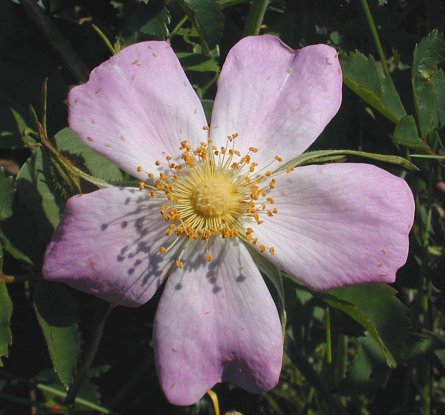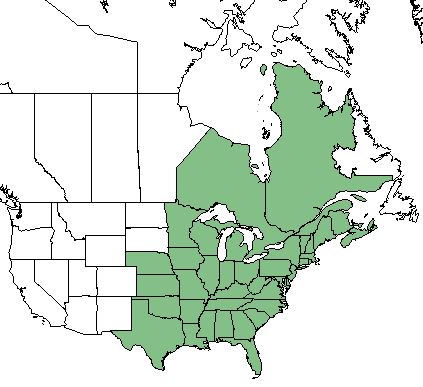Rosa carolina
Common names: Carolina Rose[1], pasture rose[2]
| Rosa carolina | |
|---|---|

| |
| Photo by John Hilty hosted at IllinoisWildflowers.info | |
| Scientific classification | |
| Kingdom: | Plantae |
| Division: | Magnoliophyta - Flowering plants |
| Class: | Magnoliopsida - Dicots |
| Order: | Rosales |
| Family: | Rosaceae |
| Genus: | Rosa |
| Species: | R. carolina |
| Binomial name | |
| Rosa carolina L. | |

| |
| Natural range of Rosa carolina from USDA NRCS Plants Database. | |
Contents
Taxonomic Notes
Synonym: R. lyoni (Pursh), R. serrulata (Rafinesque); R. lyoni' Pursh; Rosa subserrulata (Rydberg)
Variety: R. carolina var. grandifolia (Baker) Rehder
Subspecies: Rosa carolina Linnaeus ssp. carolina; Rosa carolina Linnaeus ssp. subserrulata (Rydberg) W.H. Lewis
Description
R. carolina is a perennial subshrub of the Rosaceae family that is native to North America.[1]
Distribution
Rosa carolina is found throughout the entire eastern United States as far west as Texas, as well as, Ontario and Quebec.[1]
Ecology
Habitat
Habitats for R. carolina include upland forests, wooddlands, pastures, and roadsides.[3] Specimens have been collected from pine-oak woodland, partial shade of a trail, full sun of a camping ground, edge of abandoned limestone quarry, upland oak woodland, and planted slash pine region.[4]
Coarse soils are ideal for R. carolina. It has a high tolerance for drought and a medium tolerance for fire and shade.[1]
Phenology
R. carolina has been observed to flower in April, May, and August with peak inflorescence in May.[5]
Fire ecology
Populations of Rosa carolina have been known to persist through repeated annual burning.[6]
Pollination
R. carolina is visited by ground-nesting bees from the Andrenidae family (Andrena arabis, A. crataegi, A. hippotes, A. miranda, A. nasonii, A. nivalis, A. thaspii, A. virginiana and A. w-scripta), long-tongued bees from the Apidae family (Bombus griseocollis and Xylocopa virginica) and sweat bees from the Halictidae family (Agapostemon virescens, Augochlora pura, Lasioglossum cinctipes, L. hitchensi, L. macoupinense, L. obscurum, L. truncatum and L. zonulum).[7]
Conservation, cultivation, and restoration
Cultural use
Photo Gallery
References and notes
- ↑ 1.0 1.1 1.2 1.3 USDA Plant Database
- ↑ Goldblum, D., et al. (2013). "The impact of seed mix weight on diversity and species composition in a tallgrass prairie restoration planting, Nachusa grasslands, Illinois, USA." Ecological Restoration 31(2): 154-167.
- ↑ Weakley, A. S. (2015). Flora of the Southern and Mid-Atlantic States. Chapel Hill, NC, University of North Carolina Herbarium.
- ↑ URL: http://herbarium.bio.fsu.edu. Last accessed: June 2018. Collectors: Loran C. Anderson, Gary Knight, John Nelson, R.K. Godfery, Richard Mitchell, Rodie White, R. Komarek, William Platt, Bob Farley, D.C.F. States and counties: Florida (Alachua, Leon, Jackson) Georgia (Grady, Thomas)
- ↑ Nelson, G. PanFlora: Plant data for the eastern United States with emphasis on the Southeastern Coastal Plains, Florida, and the Florida Panhandle. www.gilnelson.com/PanFlora/ Accessed: 29 MAY 2018
- ↑ Platt, W.J., R. Carter, G. Nelson, W. Baker, S. Hermann, J. Kane, L. Anderson, M. Smith, K. Robertson. 2021. Unpublished species list of Wade Tract old-growth longleaf pine savanna, Thomasville, Georgia.
- ↑ Discoverlife.org [1]